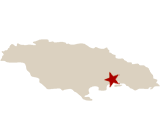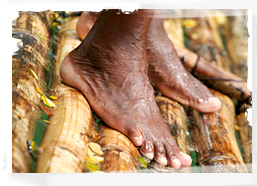An Introduction to Jamaica
The island known now as the Commonwealth of Jamaica was the Spanish colony of Santiago before it was taken by the British in 1655 and named Jamaica, at which point some of the native Tainos were still to be found there (unlike in neighbouring Hispaniola where the native population was quickly wiped out). Slaves who fled to join the Tainos in the mountainous interior of Jamaica became known as Maroons - they established free communities and maintained their freedom for generations through the 18th century. The slave trade meanwhile turned Jamaica into one of the world's leading sugar exporters and changed the population ratio from 3 whites to one black in 1600 to 20:1 in favour of blacks by the abolition of slavery in 1807. See full country profile.Latest Research News from Latin America

GOVERNMENT: parlaimentary democracy within the Commonwealth
AREA: 10,991 sq km
POPULATION: 2,868,380 (2011 est.)
MAJOR LANGUAGE: Official Language: English. Most speak English patois

Some business and general info
The Market Research Industry
Trade and Industry in Jamaica
Reggae music was first developed in Jamaica in the late 1960s. Arguably its most famous singer, Bob Marley, was born Nesta Robert Marley in the Nine Mile district of Saint Ann parish, Jamaica, the son of a white man from Sussex and an Afro-Jamaican mother. His band The Wailers produced a string of anthemic reggae songs betw'en 1963 and his death at the age of 36 in 1981, and the posthumously released triple album Legend is reggae's best-selling album, shipping 25 million copies worldwide.
Home from homeJamaica is divided into the counties of Cornwall, Middlesex and Surrey - and like its English opposite number, the island's capital city Kingston, Jamaica is also Kingston, Surrey.
Go to next country
The island known now as the Commonwealth of Jamaica was the Spanish colony of Santiago before it was taken by the British in 1655 and named Jamaica, at which point some of the native Tainos were still to be found there (unlike in neighbouring Hispaniola where the native population was quickly wiped out). Slaves who fled to join the Tainos in the mountainous interior of Jamaica became known as Maroons - they established free communities and maintained their freedom for generations through the 18th century. The slave trade meanwhile turned Jamaica into one of the world's leading sugar exporters and changed the population ratio from 3 whites to one black in 1600 to 20:1 in favour of blacks by the abolition of slavery in 1807.
Full independence was gained in 1962, followed by a few years of economic growth, which turned into decline in the 1970s and 80s. An estimated 2.5m Jamaicans now live abroad, many in the UK, US, Canada and Cuba. Jamaicans arrived in the UK from the 1950s and now c.800,000, making them by far the country's largest African-Caribbean group. Some areas of Jamaica, particularly cities such as Kingston, experience high levels of crime and violence, and mob attacks have led human rights campaigners to dub the island 'the most homophobic place on earth.'The island is home to a diversity of wildlife, including the American crocodile, the Jamaican boa, a freshwater turtle, and the Amazonian Giant Centipede and the Homerus Swallowtail, respectively the world's largest centipede and the Western Hemisphere's largest butterfly.
GDP: $35.6bn (2011 est.); $4,240 per capita
Religions Protestant 62.5% (Seventh-Day Adventist 10.8%, Pentecostal 9.5%, Other Church of God 8.3%, Baptist 7.2% and many others), Roman Catholic 2.6%, other or unspecified 14.2%, none 20.9%, (2001 census). The Rastafari movement had 24,020 adherents, according to this census.
Currency: Jamaican dollar. 88 JMD = $US 1
Telephone Code: +1 876
Jamaica has a mixed economy with service industries accounting for 60% of GDP. The majority of foreign income is derived from tourism, remittances from expats and the export of alumina and its ore bauxite. An estimated 1.3 million foreign tourists visit Jamaica every year.
Due to the global downturn the government had to reschedule its debts in January 2010 swapping high interest short term bonds for those with a lower yield over a longer period. The success of this offering allowed Jamaica to borrow US $1.27b over a three year period from the IMF. The government is now maintaining strict fiscal discipline, market liberalization and open trade. Jamaica has been a (founder) member of the Caribbean Community Single Market and Economy since 2006. The government also has to deal with high unemployment which in turn exacerbates the high crime rate.
As well as alumina and bauxite the country also exports mineral fuels. Non mining exports include: sugar, rum, coffee, yams, beverages, chemicals and wearing apparel. Exports (est. $ 1.65 billion in 2011) go mainly to the US (34%), Canada (16%), Norway (9%), the UK (7%) and the Netherlands(6%). Imports (c.$6.36bn in 2011) are food and other consumer goods, industrial supplies, fuel, parts and accessories of capital goods, machinery and transport equipment and construction materials coming from the US (33%), Venezuela (15%), Trinidad and Tobago (14%), and China (5%).
Email me:
laurence@mrweb.com

